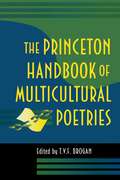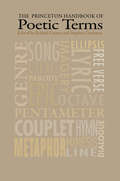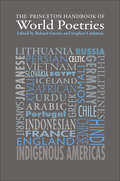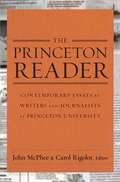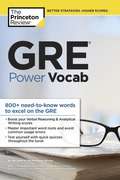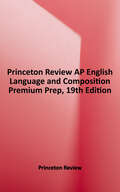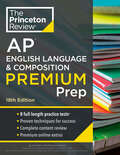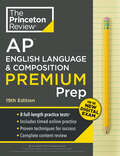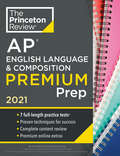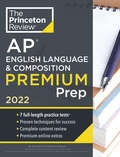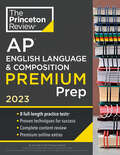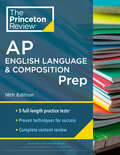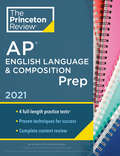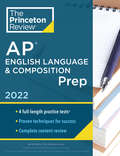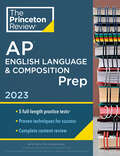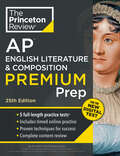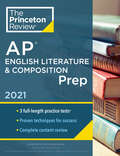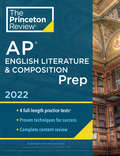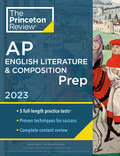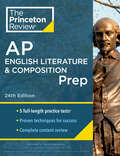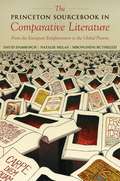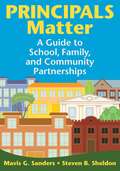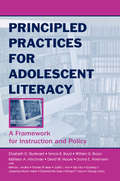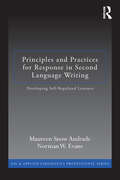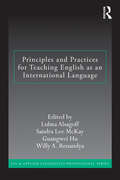- Table View
- List View
The Princeton Handbook of Multicultural Poetries
by T. V. F. BroganDrawn from the acclaimed New Princeton Encyclopedia of Poetry and Poetics, the articles in this concise new reference book provide a complete survey of the poetic history and practice in every major national literature or cultural tradition in the world. As with the parent volume, which has sold over 10,000 copies since it was first published in 1993, the intended audience is general readers, journalists, students, teachers, and researchers. The editor's principle of selection was balance, and his goal was to embrace in a structured and reasoned way the diversity of poetry as it is known across the globe today. In compiling material on 106 cultures in 92 national literatures, the book gives full coverage to Indo-European poetries (all the major Celtic, Slavic, Germanic, and Romance languages, as well as other obscure ones such as Hittite), the ancient middle Eastern poetries (Hebrew, Persian, Sumerian, and Assyro-Babylonian), subcontinental Indian poetries (the widest linguistic diversity), Asian and Pacific poetries (Chinese, Japanese, Korean, Vietnamese, Mongolian, and half a dozen others), continental American poetries (all the modern Western cultures and native Indian in North, Central, and South American regions), and African poetries (ancient and emergent, oral and written).
The Princeton Handbook of Poetic Terms: Third Edition
by Roland Greene Stephen CushmanThe Princeton Handbook of Poetic Terms--drawn from the latest edition of the acclaimed Princeton Encyclopedia of Poetry and Poetics--provides an authoritative guide to the most important terms in the study of poetry and literature. Featuring 226 fully revised and updated entries, including 100 that are new to this edition, the book offers clear and insightful definitions and discussions of critical concepts, genres, forms, movements, and poetic elements, followed by invaluable, up-to-date bibliographies that guide users to further reading and research. Because the entries are carefully selected and adapted from the Princeton Encyclopedia, the Handbook has unrivalled breadth and depth for a book of its kind, in a convenient, portable size. Fully indexed for the first time and complete with an introduction by the editors, this is an essential volume for all literature students, teachers, and researchers, as well as other readers and writers.Drawn from the latest edition of the acclaimed Princeton Encyclopedia of Poetry and PoeticsProvides 226 fully updated and authoritative entries, including 100 new to this edition, written by an international team of leading scholarsFeatures entries on critical concepts (canon, mimesis, prosody, syntax); genres, forms, and movements (ballad, blank verse, confessional poetry, ode); and terms (apostrophe, hypotaxis and parataxis, meter, tone)Includes an introduction, bibliographies, cross-references, and a full index
The Princeton Handbook of World Poetries
by Roland Greene Stephen CushmanThe Princeton Handbook of World Poetries--drawn from the latest edition of the acclaimed Princeton Encyclopedia of Poetry and Poetics--provides a comprehensive and authoritative survey of the history and practice of poetry in more than 100 major regional, national, and diasporic literatures and language traditions around the globe. With more than 165 entries, the book combines broad overviews and focused accounts to give extensive coverage of poetic traditions throughout the world. For students, teachers, researchers, poets, and other readers, it supplies a one-of-a-kind resource, offering in-depth treatment of Indo-European poetries (all the major Celtic, Slavic, Germanic, and Romance languages, and others); ancient Middle Eastern poetries (Hebrew, Persian, Sumerian, and Assyro-Babylonian); subcontinental Indian poetries (Bengali, Hindi, Marathi, Punjabi, Sanskrit, Tamil, Urdu, and more); Asian and Pacific poetries (Chinese, Japanese, Korean, Vietnamese, Mongolian, Nepalese, Thai, and Tibetan); Spanish American poetries (those of Mexico, Peru, Argentina, Chile, and many other Latin American countries); indigenous American poetries (Guaraní, Inuit, and Navajo); and African poetries (those of Ethiopia, Somalia, South Africa, and other countries, and including African languages, English, French, and Portuguese). Complete with an introduction by the editors, this is an essential volume for anyone interested in understanding poetry in an international context.Drawn from the latest edition of the acclaimed Princeton Encyclopedia of Poetry and PoeticsProvides more than 165 authoritative entries on poetry in more than 100 regional, national, and diasporic literatures and language traditions throughout the worldFeatures extensive coverage of non-Western poetic traditionsIncludes an introduction, bibliographies, cross-references, and a general index
The Princeton Reader: Contemporary Essays by Writers and Journalists at Princeton University
by John McPhee & Carol RigolotFrom a Swedish hotel made of ice to the enigma of UFOs, from a tragedy on Lake Minnetonka to the gold mine of cyberpornography, The Princeton Reader brings together more than 90 favorite essays by 75 distinguished writers. This collection of nonfiction pieces by journalists who have held the Ferris/McGraw/Robbins professorships at Princeton University offers a feast of ideas, emotions, and experiences--political and personal, light-hearted and comic, serious and controversial--for anyone to dip into, contemplate, and enjoy.The volume includes a plethora of topics from the environment, terrorism, education, sports, politics, and music to profiles of memorable figures and riveting stories of survival. These important essays reflect the high-quality work found in today's major newspapers, magazines, broadcast media, and websites. The book's contributors include such outstanding writers as Ken Armstrong of the Seattle Times; Jill Abramson, Jim Dwyer, and Walt Bogdanich of the New York Times; Evan Thomas of Newsweek; Joel Achenbach and Marc Fisher of the Washington Post; Nancy Gibbs of Time; and Jane Mayer, John McPhee, John Seabrook, and Alex Ross of the New Yorker.The perfect collection for anyone who enjoys compelling narratives, The Princeton Reader contains a depth and breadth of nonfiction that will inspire, provoke, and endure.
The Princeton Review: GRE Power Vocab
by Anne Curtis The Staff of The Princeton ReviewThis book is filled with useful definitions and study tips for over 800 words, along with skills for decoding unfamiliar ones and strategies that help to liven up flashcards and boost memorization techniques.
Princeton Review AP English Language and Composition Prep, 19th Edition
by The Staff of The Princeton ReviewPremium Practice For A Perfect 5! Ace the new Digital AP English Language & Composition Exam with The Princeton Review's comprehensive study guide—including 8 practice tests with answer explanations, timed online practice, and thorough content reviews. Techniques That Work - Tried-and-true strategies to help you avoid traps and beat the test - Tips for pacing yourself and guessing logically - Essential tactics to help you work smarter, not harder Everything You Need for a High Score - Updated to address the new digital exam - Comprehensive review of the synthesis, rhetorical analysis, and argumentative essays - Online digital flashcards to review core content - Access to study guides, a handy list of key terms and concepts, helpful pre-college information, and more via your online Student Tools Premium Practice for AP Excellence - 8 full-length practice tests (5 in the book, 3 online) with detailed answer explanations - Online tests provided as both digital versions (with timer option to simulate exam experience) online, and as downloadable PDFs (with interactive elements mimicking the exam interface) - Pacing drills to help you maximize points on the Reading and Writing passages
Princeton Review AP English Language & Composition Premium Prep, 18th Edition: 8 Practice Tests + Complete Content Review + Strategies & Techniques (College Test Preparation)
by The Princeton ReviewPREMIUM PREP FOR A PERFECT 5! Ace the AP English Language & Composition Exam with this Premium version of The Princeton Review's comprehensive study guide—including 8 full-length practice tests with complete explanations, thorough content reviews, targeted strategies for every section of the exam, and access to online extras.Techniques That Actually Work• Tried-and-true strategies to help you avoid traps and beat the test• Tips for pacing yourself and guessing logically• Essential tactics to help you work smarter, not harderEverything You Need for a High Score• Up-to-date information on the AP English Language & Composition Exam• Comprehensive review of the synthesis, rhetorical analysis, and argumentative essays• Engaging coverage of word use and rhetorical modes• Access to study plans, a list of key terms, helpful pre-college information, and more via your online Student ToolsPremium Practice for AP Excellence• 8 full-length practice tests (5 in the book, 3 online) with detailed answer explanations• Pacing drills to help you maximize points on the Reading and Writing passages• Detailed guides for the new analytical scoring rubrics
Princeton Review AP English Language & Composition Premium Prep, 19th Edition: 8 Practice Tests + Digital Practice Online + Content Review (College Test Preparation)
by The Princeton ReviewPREMIUM PRACTICE FOR A PERFECT 5! Ace the new Digital AP English Language & Composition Exam with The Princeton Review's comprehensive study guide—including 8 practice tests with answer explanations, timed online practice, and thorough content reviews.Techniques That Actually Work• Tried-and-true strategies to help you avoid traps and beat the test• Tips for pacing yourself and guessing logically• Essential tactics to help you work smarter, not harderEverything You Need for a High Score• Updated to address the new digital exam• Comprehensive review of the synthesis, rhetorical analysis, and argumentative essays• Online digital flashcards to review core content• Access to study guides, a handy list of key terms and concepts, helpful pre-college information, and more via your online Student ToolsPremium Practice for AP Excellence• 8 full-length practice tests (5 in the book, 3 online) with detailed answer explanations• Online tests provided as both digital versions (with timer option to simulate exam experience) online, and as downloadable PDFs (with interactive elements mimicking the exam interface)• Pacing drills to help you maximize points on the Reading and Writing passages
Princeton Review AP English Language & Composition Premium Prep, 2021: 7 Practice Tests + Complete Content Review + Strategies & Techniques (College Test Preparation)
by The Princeton ReviewPREMIUM PREP FOR A PERFECT 5—now with 40% more practice than previous editions! Ace the 2021 AP English Language & Composition Exam with this Premium version of The Princeton Review's comprehensive study guide—including 7 full-length practice tests with complete explanations, thorough content reviews, targeted strategies for every section of the exam, and access to online extras.Techniques That Actually Work.• Tried-and-true strategies to help you avoid traps and beat the test• Tips for pacing yourself and guessing logically• Essential tactics to help you work smarter, not harderEverything You Need to Know to Help Achieve a High Score.• Comprehensive review of the synthesis, rhetorical analysis,and argumentative essays• Engaging coverage of word use and rhetorical modes to help you improve your writing progress• Updated to align with the latest College Board standards• Access to study plans, a handy list of key terms, helpful pre-college information, and more via your online Student ToolsPremium Practice for AP Excellence.• 7 full-length practice tests (4 in the book, 3 online) with detailed answer explanations• Pacing drills to help you maximize points on the Reading and new Writing passages• Detailed guides for the new analytical scoring rubrics
Princeton Review AP English Language & Composition Premium Prep, 2022: 7 Practice Tests + Complete Content Review + Strategies & Techniques (College Test Preparation)
by The Princeton ReviewPREMIUM PREP FOR A PERFECT 5! Ace the 2022 AP English Language & Composition Exam with this Premium version of The Princeton Review's comprehensive study guide—including 7 full-length practice tests with complete explanations, thorough content reviews, targeted strategies for every section of the exam, and access to online extras.Techniques That Actually Work.• Tried-and-true strategies to help you avoid traps and beat the test• Tips for pacing yourself and guessing logically• Essential tactics to help you work smarter, not harderEverything You Need for a High Score.• Up-to-date information on the 2022 AP English Language & Composition Exam• Comprehensive review of the synthesis, rhetorical analysis, and argumentative essays• Engaging coverage of word use and rhetorical modes• Access to study plans, a list of key terms, helpful pre-college information, and more via your online Student Tools accountPremium Practice for AP Excellence.• 7 full-length practice tests (4 in the book, 3 online) with detailed answer explanations• Pacing drills to help you maximize points on the Reading and Writing passages• Detailed guides for the new analytical scoring rubrics
Princeton Review AP English Language & Composition Premium Prep, 2023: 8 Practice Tests + Complete Content Review + Strategies & Techniques (College Test Preparation)
by The Princeton ReviewPREMIUM PREP FOR A PERFECT 5! Ace the 2023 AP English Language & Composition Exam with this Premium version of The Princeton Review's comprehensive study guide—including 8 full-length practice tests with complete explanations, thorough content reviews, targeted strategies for every section of the exam, and access to online extras. Techniques That Actually Work • Tried-and-true strategies to help you avoid traps and beat the test • Tips for pacing yourself and guessing logically • Essential tactics to help you work smarter, not harder Everything You Need for a High Score • Up-to-date information on the 2023 AP English Language & Composition Exam • Comprehensive review of the synthesis, rhetorical analysis, and argumentative essays • Engaging coverage of word use and rhetorical modes • Access to study plans, a list of key terms, helpful pre-college information, and more via your online Student Tools Premium Practice for AP Excellence • 8 full-length practice tests (5 in the book, 3 online) with detailed answer explanations • Pacing drills to help you maximize points on the Reading and Writing passages • Detailed guides for the new analytical scoring rubrics
Princeton Review AP English Language & Composition Prep, 18th Edition: 5 Practice Tests + Complete Content Review + Strategies & Techniques (College Test Preparation)
by The Princeton ReviewEVERYTHING YOU NEED TO SCORE A PERFECT 5! Ace the AP English Language & Composition Exam with this comprehensive study guide—including 5 full-length practice tests with complete explanations, thorough content reviews, targeted strategies for every section of the exam, and access to online extras.Techniques That Actually Work• Tried-and-true strategies to help you avoid traps and beat the test• Tips for pacing yourself and guessing logically• Essential tactics to help you work smarter, not harderEverything You Need for a High Score• Up-to-date information on the AP English Language & Composition Exam• Comprehensive review of the synthesis, rhetorical analysis, and argumentative essays• Engaging coverage of word use and rhetorical modes• Access to study plans, a list of key terms, helpful pre-college information, and more via your online Student ToolsPractice You Way to Excellence• 5 full-length practice tests (4 in the book, 1 online) with detailed answer explanations• Pacing drills to help you maximize points on the Reading and Writing passages• Detailed guides for the new analytical scoring rubrics
Princeton Review AP English Language & Composition Prep, 2021: 4 Practice Tests + Complete Content Review + Strategies & Techniques (College Test Preparation)
by The Princeton ReviewEVERYTHING YOU NEED TO SCORE A PERFECT 5—now with 2x the practice of previous editions!Ace the 2021 AP English Language & Composition Exam with this comprehensive study guide—including 4 full-length practice tests with complete explanations, thorough content reviews, targeted strategies for every section of the exam, and access to online extras.Techniques That Actually Work.• Tried-and-true strategies to help you avoid traps and beat the test• Tips for pacing yourself and guessing logically• Essential tactics to help you work smarter, not harderEverything You Need to Know to Help Achieve a High Score.• Comprehensive review of the synthesis, rhetorical analysis,and argumentative essays• Engaging coverage of word use and rhetorical modes to help you improve your writing progress• Updated to align with the latest College Board standards• Access to study plans, a handy list of key terms, helpful pre-college information, and more via your online Student ToolsPremium Practice for AP Excellence.• 4 full-length practice tests (3 in the book, 1 online) with detailed answer explanations• Pacing drills to help you maximize points on the Reading and new Writing passages• Detailed guides for the new analytical scoring rubrics
Princeton Review AP English Language & Composition Prep, 2022: 4 Practice Tests + Complete Content Review + Strategies & Techniques (College Test Preparation)
by The Princeton ReviewEVERYTHING YOU NEED TO SCORE A PERFECT 5! Ace the 2022 AP English Language & Composition Exam with this comprehensive study guide—including 4 full-length practice tests with complete explanations, thorough content reviews, targeted strategies for every section of the exam, and access to online extras.Techniques That Actually Work.• Tried-and-true strategies to help you avoid traps and beat the test• Tips for pacing yourself and guessing logically• Essential tactics to help you work smarter, not harderEverything You Need for a High Score.• Up-to-date information on the 2022 AP English Language & Composition Exam• Comprehensive review of the synthesis, rhetorical analysis, and argumentative essays• Engaging coverage of word use and rhetorical modes• Access to study plans, a list of key terms, helpful pre-college information, and more via your online Student Tools accountPremium Practice for AP Excellence.• 4 full-length practice tests (3 in the book, 1 online) with detailed answer explanations• Pacing drills to help you maximize points on the Reading and Writing passages• Detailed guides for the new analytical scoring rubrics
Princeton Review AP English Language & Composition Prep, 2023: 5 Practice Tests + Complete Content Review + Strategies & Techniques (College Test Preparation)
by The Princeton ReviewEVERYTHING YOU NEED TO SCORE A PERFECT 5! Ace the 2023 AP English Language & Composition Exam with this comprehensive study guide—including 5 full-length practice tests with complete explanations, thorough content reviews, targeted strategies for every section of the exam, and access to online extras. Techniques That Actually Work • Tried-and-true strategies to help you avoid traps and beat the test • Tips for pacing yourself and guessing logically • Essential tactics to help you work smarter, not harder Everything You Need for a High Score • Up-to-date information on the 2023 AP English Language & Composition Exam • Comprehensive review of the synthesis, rhetorical analysis, and argumentative essays • Engaging coverage of word use and rhetorical modes • Access to study plans, a list of key terms, helpful pre-college information, and more via your online Student ToolsPractice You Way to Excellence • 5 full-length practice tests (4 in the book, 1 online) with detailed answer explanations • Pacing drills to help you maximize points on the Reading and Writing passages • Detailed guides for the new analytical scoring rubrics
Princeton Review AP English Literature & Composition Premium Prep, 25th Edition: 5 Practice Tests + Digital Practice Online + Content Review (College Test Preparation)
by The Princeton ReviewPREMIUM PRACTICE FOR A PERFECT 5! Ace the new Digital AP English Literature & Composition Exam with The Princeton Review's comprehensive study guide—including 5 practice tests with answer explanations, timed online practice, and thorough content reviews.Techniques That Actually Work• Tried-and-true strategies to help you avoid traps and beat the test• Tips for pacing yourself and guessing logically• Essential tactics to help you work smarter, not harderEverything You Need for a High Score• Updated to address the new digital exam• Comprehensive review of the synthesis, rhetorical analysis, and argumentative essays• Coverage of terminology and rhetorical modes for improved writing• Online digital flashcards to review core content, plus study plans and more via your online Student ToolsPremium Practice for AP Excellence• 5 full-length practice tests (4 in the book, 1 online) with detailedanswer explanations• Online test provided as both a digital version (with timer option to simulate exam experience) online, and as a downloadable PDF (with interactive elements mimicking the exam interface)• Pacing drills and detailed analytical scoring rubric guides
Princeton Review AP English Literature & Composition Prep, 2021: Practice Tests + Complete Content Review + Strategies & Techniques (College Test Preparation)
by The Princeton ReviewEVERYTHING YOU NEED TO HELP SCORE A PERFECT 5—now with 33% more practice than previous editions! Ace the 2021 AP English Literature & Composition Exam with The Princeton Review's comprehensive study guide. Includes 3 full-length practice tests, thorough content reviews, targeted strategies for every section, and access to online extras.Techniques That Actually Work.• Tried-and-true strategies to help you avoid traps and beat the test• Tips for pacing yourself and guessing logically• Essential tactics to help you work smarter, not harderEverything You Need to Know to Help Achieve a High Score.• Comprehensive coverage of all test topics• Up-to-date information on the 2021 course & exam• Engaging activities to help you critically assess your progress• Access to study plans, helpful pre-college information, and more via your online Student ToolsPractice Your Way to Excellence.• 3 full-length practice tests with detailed answer explanations• Practice drills for poetry and prose passages• Sample essays with tips to help you effectively plan and organize your own writing on the day of the exam
Princeton Review AP English Literature & Composition Prep, 2022: 4 Practice Tests + Complete Content Review + Strategies & Techniques (College Test Preparation)
by The Princeton ReviewEVERYTHING YOU NEED TO HELP SCORE A PERFECT 5! Ace the 2022 AP English Literature & Composition Exam with The Princeton Review's comprehensive study guide. Includes 4 full-length practice tests, thorough content reviews, targeted strategies for every section, and access to online extras.Techniques That Actually Work.• Tried-and-true strategies to help you avoid traps and beat the test• Tips for pacing yourself and guessing logically• Essential tactics to help you work smarter, not harderEverything You Need for a High Score.• Fully aligned with the latest College Board standards for AP® English Literature & Composition• Comprehensive coverage of all test topics• Engaging activities to help you critically assess your progress• Access to study plans, helpful pre-college information, and more via your online Student Tools accountPractice Your Way to Excellence.• 4 full-length practice tests (3 in the book, 1 online) with detailed answer explanations• Practice drills for poetry and prose passages• Sample essays with tips to help you effectively plan and organize your writing on the day of the exam
Princeton Review AP English Literature & Composition Prep, 2023: 5 Practice Tests + Complete Content Review + Strategies & Techniques (College Test Preparation)
by The Princeton ReviewEVERYTHING YOU NEED TO HELP SCORE A PERFECT 5! Ace the 2023 AP English Literature & Composition Exam with The Princeton Review's comprehensive study guide. Includes 5 full-length practice tests, thorough content reviews, targeted strategies for every section, and access to online extras. Techniques That Actually Work • Tried-and-true strategies to help you avoid traps and beat the test • Tips for pacing yourself and guessing logically • Essential tactics to help you work smarter, not harder Everything You Need for a High Score • Fully aligned with the latest College Board standards for AP® English Literature & Composition • Comprehensive coverage of all test topics • Engaging activities to help you critically assess your progress • Access to study plans, helpful pre-college information, and more via your online Student Tools Practice Your Way to Excellence • 5 full-length practice tests (4 in the book, 1 online) with detailed answer explanations • Practice drills for poetry and prose passages • Sample essays with tips to help you effectively plan and organize your writing on the day of the exam
Princeton Review AP English Literature & Composition Prep, 24th Edition: 5 Practice Tests + Complete Content Review + Strategies & Techniques (College Test Preparation)
by The Princeton ReviewEVERYTHING YOU NEED TO HELP SCORE A PERFECT 5! Ace the AP English Literature & Composition Exam with The Princeton Review's comprehensive study guide. Includes 5 full-length practice tests, thorough content reviews, targeted strategies for every section, and access to online extras.Techniques That Actually Work• Tried-and-true strategies to help you avoid traps and beat the test• Tips for pacing yourself and guessing logically• Essential tactics to help you work smarter, not harderEverything You Need for a High Score• Fully aligned with the latest College Board standards for AP® English Literature & Composition• Comprehensive coverage of all test topics• Engaging activities to help you critically assess your progress• Access to study plans, helpful pre-college information, and more via your online Student ToolsPractice Your Way to Excellence• 5 full-length practice tests (4 in the book, 1 online) with detailed answer explanations• Practice drills for poetry and prose passages• Sample essays with tips to help you effectively plan and organize your writing on the day of the exam
The Princeton Sourcebook in Comparative Literature: From the European Enlightenment to the Global Present (Translation/Transnation #22)
by David Damrosch, Natalie Melas & Mbongiseni ButheleziKey essays on comparative literature from the eighteenth century to todayAs comparative literature reshapes itself in today's globalizing age, it is essential for students and teachers to look deeply into the discipline's history and its present possibilities. The Princeton Sourcebook in Comparative Literature is a wide-ranging anthology of classic essays and important recent statements on the mission and methods of comparative literary studies. This pioneering collection brings together thirty-two pieces, from foundational statements by Herder, Madame de Staël, and Nietzsche to work by a range of the most influential comparatists writing today, including Lawrence Venuti, Gayatri Chakravorty Spivak, and Franco Moretti. Gathered here are manifestos and counterarguments, essays in definition, and debates on method by scholars and critics from the United States, Europe, Asia, Africa, and Latin America, giving a unique overview of comparative study in the words of some of its most important practitioners. With selections extending from the beginning of comparative study through the years of intensive theoretical inquiry and on to contemporary discussions of the world's literatures, The Princeton Sourcebook in Comparative Literature helps readers navigate a rapidly evolving discipline in a dramatically changing world.
Principals Matter: A Guide to School, Family, and Community Partnerships
by Steven B. Sheldon Mavis G. SandersResearch has shown that strong principal leadership is critical to developing effective school partnerships that include diverse school, family and community members. This book provides administrators with a clear road map for initiating partnership programs that are goal-focused, equitable, and sustainable.In this research-based resource, the authors highlight the work of principals who have cultivated successful partnerships across many settings to show other school leaders how they can develop the necessary supportive school cultures. Examining the administrator's role in the success and quality of home-school partnerships and student outcomes, this guidebook: Synthesizes research on principal leadership, school and community partnerships, and urban education reform Discusses the role of fathers in children’s learning and working with families that live in poverty, are linguistically diverse, or have children with disabilities Offers practical recommendations for evaluating and refining partnership programs to ensure they are linked with student achievement goals
Principled Practices for Adolescent Literacy: A Framework for Instruction and Policy
by David W. Moore Kathleen A. Hinchman Donna E. Alvermann William G. Brozo Fenice B. Boyd Elizabeth G. SturtevantThis book presents an evidence-based framework for understanding the literacy needs of adolescents. The premise is that educators and other critical stakeholders need to understand evidence-based principles in order to develop effective curriculum to meet the needs of diverse learners. Recommendations are provided for middle and secondary education, professional development, teacher education research and policy.At the center of the book are Eight Guiding Principles developed by the authors through a process that included an extensive review of research and policy literature in literacy and related fields, a comparison of National Standards documents, and visits to the classrooms of 28 middle and high school teachers across the United States. The Principles are broad enough to encompass a variety of contexts and student needs, yet specific enough to offer real support to those involved in program development or policy decisions. They provide an overarching structure that districts and teachers can use to develop site-specific curriculum that is both research-based and designed to meet the needs of the learners for whom they are responsible.Important Text Features: Organized to help readers understand empirically supported principles of practice that can be used to address literacy concerns in today's schools, each chapter that addresses one of the eight Principles follows a similar format:* The Principle is presented along with a brief explanation of the research base and a sample of national standards that support it.* One or more case examples spanning a wide variety of disciplines, grade levels, and local conditions - provide an in-depth look at the Principle in action.* A well-known adolescent literacy expert offers a response to each case example, giving readers an informed view of the importance of the Principle, how it is enacted in the cases, and examples of other work related to the Principle. Discussion questions are provided that can be used for individual reflection or group discussion.Principled Practices for Adolescent Literacy is intended as a text for pre-service and in-service upper-elementary, middle and high school literacy methods courses and graduate courses related to adolescent literacy, and as a resource for school district personnel, policymakers and parents.
Principles and Practices for Response in Second Language Writing: Developing Self-Regulated Learners (ESL & Applied Linguistics Professional Series)
by Maureen Snow Andrade Norman W. EvansBased on the assumptions that students expect feedback and want to improve, and that improvement is possible, this book introduces a framework that applies the theory of self-regulated learning to guide second language writing teachers’ response to learners at all stages of the writing process. This approach provides teachers with principles and activities for helping students to take more responsibility for their own learning. By using self-regulated learning strategies, students can increase their independence from the teacher, improve their writing skills, and continue to make progress once the course ends, with or without teacher guidance. The book focuses on the six dimensions of self-regulated learning —motive, methods of learning, time, physical environment, social environment, and performance. Each chapter offers practical activities and suggestions for implementing the principles and guidelines, including tools and materials that teachers can immediately use.
Principles and Practices for Teaching English as an International Language (ESL & Applied Linguistics Professional Series)
by Lubna Alsagoff Willy A. Renandya Guangwei Hu Sandra Lee McKayWhat general principles should inform a socioculturally sensitive pedagogy for teaching English as an International Language and what practices would be consistent with these principles? This text explores the pedagogical implications of the continuing spread of English and its role as an international language, highlighting the importance of socially sensitive pedagogy in contexts outside inner circle English-speaking countries. It provides comprehensive coverage of topics traditionally included in second language methodology courses (such as the teaching of oral skills and grammar), as well as newer fields (such as corpora in language teaching and multimodality); features balanced treatment of theory and practice; and encourages teachers to apply the pedagogical practices to their own classrooms and to reflect on the effects of such practices. Designed for pre-service and in-service teachers of English around the world, Principles and Practices for Teaching English as an International Language fills a critical need in the field.
